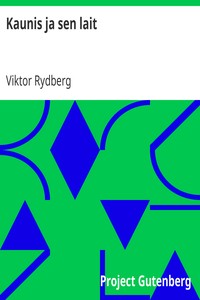| Author |
Rydberg, Viktor, 1828-1895 |
| Translator |
Palola, Eino, 1885-1951 |
| Uniform Title |
Det sköna och dess lagar. Finnish
|
| Title |
Kaunis ja sen lait
|
| Note |
Reading ease score: 16.4 (College graduate level). Very difficult to read.
|
| Credits |
Produced by Juhani Kärkkäinen and Tapio Riikonen
|
| Summary |
"Kaunis ja sen lait" by Viktor Rydberg is a philosophical treatise focusing on aesthetics, written in the late 19th century. This work derives from lectures given by Rydberg at the University of Gothenburg in 1881, compiling his thoughts on the nature of art, beauty, and their development through human history. The text delves into the fundamental principles underpinning beauty and aesthetics, suggesting a deep interconnection between art, culture, and human consciousness. The opening portion of the work establishes Rydberg's viewpoint that art and beauty are rooted in a complex interplay of emotional and intellectual currents within humanity. He argues that the essence of art is not random but is intrinsically linked to the development of human thought and aspiration for beauty. At the start, Rydberg emphasizes that humanity's unique capacity for idealism separates it from animals, leading to the creation of art as a conscious pursuit. He posits that as aesthetic impressions evolve through time, they reflect broader cultural and historical contexts, necessitating an understanding of aesthetic judgments in relation to individual and collective human experience. (This is an automatically generated summary.)
|
| Language |
Finnish |
| LoC Class |
BH: Philosophy, Psychology, Religion: Aesthetics
|
| Subject |
Aesthetics
|
| Subject |
Art -- Philosophy
|
| Category |
Text |
| EBook-No. |
58087 |
| Release Date |
Oct 13, 2018 |
| Copyright Status |
Public domain in the USA. |
| Downloads |
82 downloads in the last 30 days. |
|
Project Gutenberg eBooks are always free!
|

